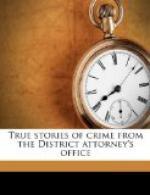Microscopic examination showed that among the words “Alice” and “Kauser” on the practice sheets some one had written a capital “M.” One of the legs of the “M” crossed and was superimposed upon a letter in the word “Alice.” Hence, whoever wrote the “M” knew what was on the practice sheet. An enlargement of this “M” and a comparison of it with the “M” in the defendant’s signature to her formal examination in the police court, with the “M” in “Mr.” in the address on the envelope and with that in the “Mrs.” on the “Peabody sheet,” rendered it obvious that they were all written by one and the same hand. Therefore it was clear that the defendant was familiar with the contents of the practice sheets (Fig. 8.), even if she had not written them herself and had not told the truth in this regard.
Moreover, it was fairly easy to see that the same hand that had written the words “I am upstairs in the bath-room” upon the second practice sheet had at the same time and with the same pen written the rest of the sheet. This was clearly perceptible on examining the “e’s” and “a’s.”
A comparison of the address “Mr. Geo. B. Lang” (on Fig. 1) with the name Mrs. James D. Singley (on Fig. 4) also shows clearly that one and the same person wrote them both. And to the accuracy of all these self-evident propositions a leading handwriting expert in New York added his unqualified opinion.
Thus, but for a little carelessness in failing to destroy odd scraps of paper and to disguise her penmanship which it seemed to her quite unnecessary to do, as in the address of the “Lang” envelope, Mrs. Parker might well have gone free after all.
It is impossible to describe all the varied dramatic features of this interesting case. No one who was present is likely to forget the impression made by the defendant at her second trial, when in defiance of overwhelming proof she still struggled to vindicate herself.
Her counsel contended throughout the trial that she was a hitherto innocent young woman led astray and started upon a criminal career by a rascally husband, whom she still loved devotedly and for whose sake she had prepared to confess herself a criminal. That James Parker introduced his wife to a life of crime there can be no doubt, but that she had a natural predilection for it must be equally obvious. It is probably true that Mabel Parker’s affection for her convict husband was unfeigned and deep. The natural repugnance of the American jury for convicting a woman was shown when in spite of the overwhelming proof upon the Parker woman’s second trial the jury remained out eight hours and then found her guilty of “uttering only,” with a strong recommendation for mercy. She was sentenced to the Bedford Reformatory.
[Illustration: Fig. 8—One of the loose sheets upon which Mabel Parker illustrated her methods and her skill as a penman to the supposed ex-convict “Hickey.”]




